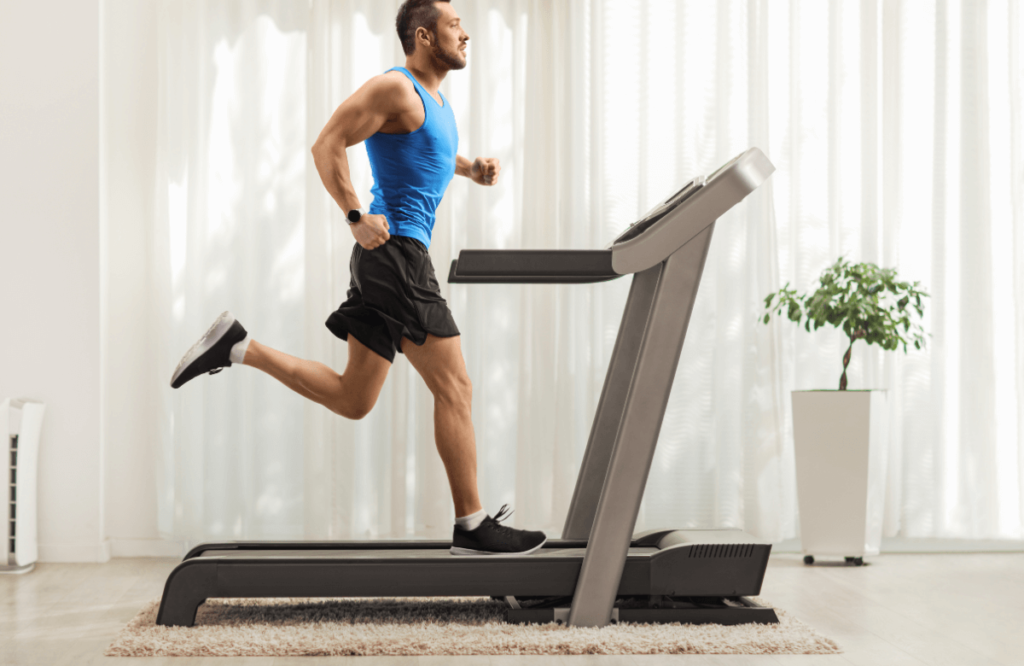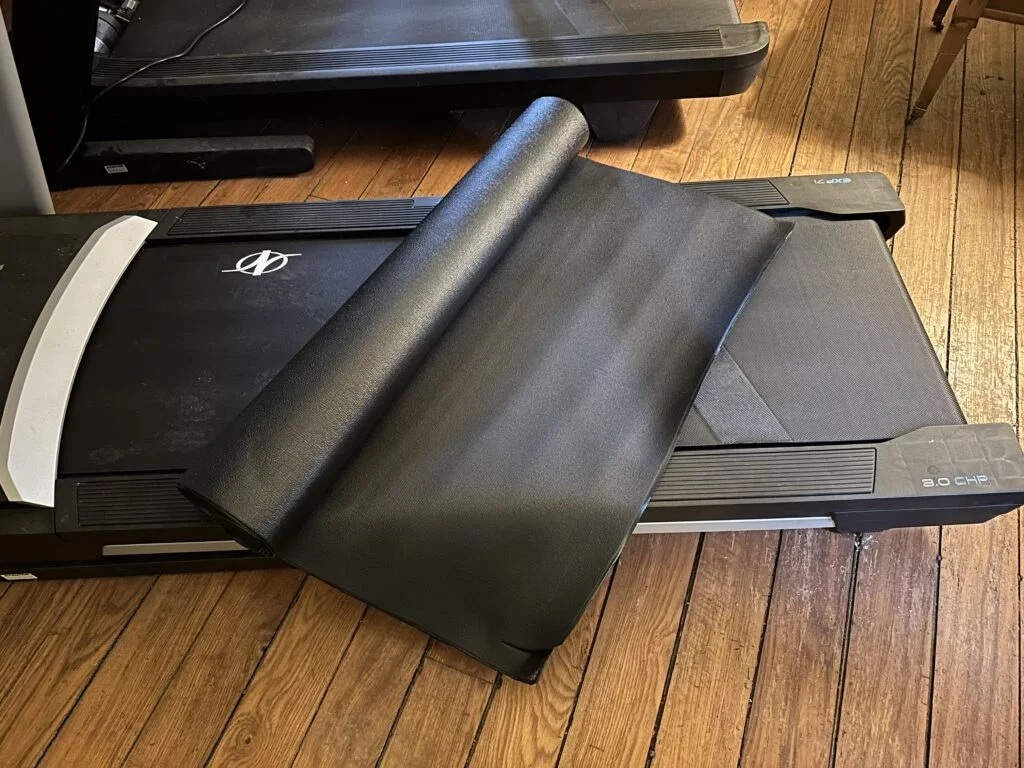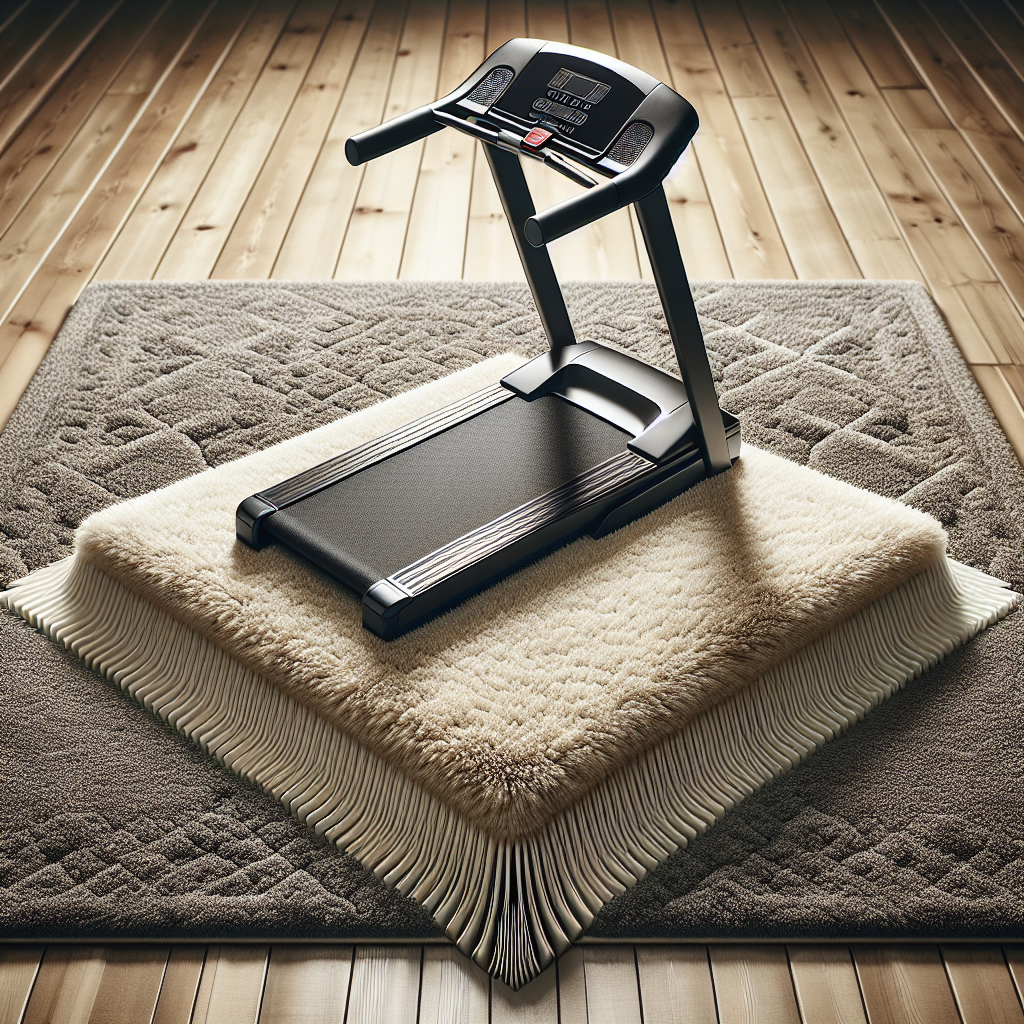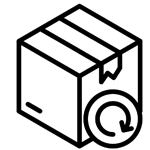Have you ever wondered what the best solution is for protecting your carpet while using a treadmill? It’s a common concern, especially for those who have carpeted floors in their homes. In this article, we will explore the various options available and discuss the pros and cons of each. By the end, you’ll have all the information you need to make an informed decision on what to put under your treadmill on carpet. So let’s get started!

Why do you need a mat under a treadmill?
When using a treadmill on carpet, it is highly recommended to have a mat underneath it. There are two main reasons for this – noise reduction and floor protection.
Noise reduction
One of the biggest advantages of having a mat under a treadmill on carpet is the significant reduction in noise. Treadmills can be quite loud, especially when used at higher speeds or during intense workouts. The vibrations generated by the machine can easily travel through the carpet and disturb others in the house or apartment building.
By placing a mat under your treadmill, you can greatly minimize the noise produced by the machine. The mat acts as a cushioning layer, absorbing the vibrations and preventing them from reverberating through the floor. This is particularly important if you live in an apartment or have downstairs neighbors who may be sensitive to noise.
Floor protection
Another important reason to use a mat under a treadmill on carpet is to protect your flooring. Treadmills are heavy machines, and the constant movement and vibrations can cause damage to the carpet and floor beneath. Over time, this can result in indentation marks, fraying or tearing of the carpet, and scratches or dents on hardwood or laminate floors.
A proper treadmill mat provides a protective barrier between the treadmill and the carpet, preventing any potential damage to the floor. It helps distribute the weight of the machine evenly, reducing the risk of indentations or imprints. Additionally, the mat can also prevent any dust or debris from accumulating beneath the treadmill, keeping your carpet or floor clean and in good condition.
Factors to consider when choosing a mat
Before purchasing a mat for your treadmill on carpet, there are several factors to consider. These factors will ensure that you choose the right mat that suits your needs and provides optimal performance.
Size
First and foremost, you need to choose a mat that matches the dimensions of your treadmill. Measure the length and width of your treadmill and select a mat that is slightly larger to ensure complete coverage. Having a mat that is too small may result in the edges of the treadmill extending beyond the mat, making it less stable and potentially causing accidents.
Material
Mats for treadmills on carpet are typically made from different materials, each with its own advantages and disadvantages. The most common materials used for treadmill mats include rubber, PVC, foam, and interlocking materials.
Rubber mats are durable, provide good shock absorption, and are resistant to slipping, making them a popular choice for carpeted floors. PVC mats are lightweight, easy to clean, and offer good protection against moisture. Foam mats are soft and cushioning, providing excellent shock absorption but may not be as long-lasting as rubber or PVC mats. Interlocking mats are versatile and can be customized to fit any size or shape of treadmill.
Thickness
The thickness of the mat is an important consideration, as it determines its shock absorption capabilities. Thicker mats generally offer better cushioning and vibration reduction. However, keep in mind that a very thick mat may also raise the height of the treadmill, affecting the user’s balance and stability.
Weight capacity
When choosing a mat, it’s crucial to check its weight capacity. Ensure that the mat is capable of supporting the weight of your treadmill. Most mats specify their weight capacity, so be sure to select one that is suitable for your treadmill model.
Types of mats for treadmills on carpet
There are several types of mats available for treadmills on carpet, each with its own unique features and benefits. Here are some of the most common types:
Rubber mats
Rubber mats are a popular choice due to their durability and ability to withstand heavy weights and constant use. They provide excellent shock absorption and prevent the treadmill from sliding or moving during workouts. Rubber mats also offer good noise reduction properties, making them an ideal choice for carpeted floors.
PVC mats
PVC mats are lightweight and easy to clean, making them a convenient option for treadmill users. They offer good resistance against moisture, ensuring the carpet or floor remains protected. PVC mats also provide decent shock absorption, although they may not be as durable as rubber mats.
Foam mats
Foam mats are known for their softness and cushioning properties. They offer excellent shock absorption, reducing the impact on joints and providing a comfortable surface to walk or run on. However, foam mats may not be as long-lasting as rubber or PVC mats and may compress over time, requiring replacement.
Interlocking mats
Interlocking mats are versatile and customizable, allowing you to create a perfect fit for your treadmill. They consist of individual tiles that can be connected together to form a mat of any size or shape. Interlocking mats offer good shock absorption and protection for carpeted floors, but they may require additional maintenance to ensure they stay securely connected.
Treadmill-specific mats
Some manufacturers offer treadmill-specific mats that are designed to perfectly fit their treadmill models. These mats are often made of high-quality materials and may feature additional features like built-in shock absorption or noise reduction. While these mats can be more expensive, they ensure a perfect fit and can enhance the performance and longevity of your treadmill.
Other alternatives to consider
If you are unable to or prefer not to use a mat, there are alternative options to consider for placing your treadmill on carpet.
Plywood or MDF board
Using a layer of plywood or MDF (medium-density fiberboard) board under your treadmill can provide a stable and more even surface. This helps reduce vibrations and prevents the treadmill from sinking into the carpet. However, it’s important to ensure that the board is thick and strong enough to support the weight of the machine.
Rubber underlayment
Rubber underlayment is a thick cushioning material that can be placed under the carpet to provide additional support and shock absorption. It acts as a barrier between the carpet and the floor, minimizing vibrations and protecting the carpet from damage. Rubber underlayment can be a good option if you want to provide extra cushioning without using a separate treadmill mat.
Carpet tiles
Another alternative is to use carpet tiles underneath your treadmill. Carpet tiles are smaller sections of carpet that can be easily installed and replaced, providing a stable and protective surface for your treadmill. They can be rearranged or replaced if any damage or wear occurs, making them a flexible option for carpeted floors.
Guidelines for using a mat under a treadmill
To ensure the proper use and effectiveness of a mat under your treadmill on carpet, it’s important to follow these guidelines:
Proper installation
When installing the mat, make sure it is placed directly under the treadmill, covering the entire footprint of the machine. Ensure that it is properly aligned and centered to provide stability and prevent the treadmill from slipping or moving during use. It’s also important to check that the mat is flat and free from any folds or wrinkles that could cause tripping hazards.
Maintenance and cleaning
Regular maintenance and cleaning of the mat are essential to keep it in good condition and prolong its lifespan. Vacuum the mat regularly to remove any dust, dirt, or debris that may accumulate. Additionally, wipe down the mat with a damp cloth or mild cleaning solution to remove any stains or spills. Avoid using harsh chemicals or abrasive cleaners that could damage the mat’s surface.
FAQs about using a mat under a treadmill on carpet
Here are some frequently asked questions about using a mat under a treadmill on carpet:
Can I use my treadmill directly on the carpet?
While it is technically possible to use a treadmill directly on carpet, it is not recommended. Treadmills generate vibrations that can travel through the carpet and disturb others in the house. Additionally, the constant movement and weight of the machine can cause damage to the carpet over time. Using a mat provides necessary noise reduction and floor protection.
Do I need a mat if my treadmill is already on a carpeted surface?
Yes, even if your treadmill is already on a carpeted surface, it is still beneficial to use a mat underneath it. The mat will provide additional cushioning, noise reduction, and floor protection. It will help distribute the weight of the machine and absorb vibrations, reducing the risk of damage to the carpet or floor.
Can I use a yoga mat under a treadmill?
It is not recommended to use a yoga mat under a treadmill. Yoga mats are typically thin and not designed to withstand the weight and vibration of a treadmill. They can get damaged or torn easily and may not provide adequate protection for your carpet or floor. It’s best to invest in a mat specifically designed for treadmills.
Yes, treadmill mats can also be used on hard floor surfaces, such as hardwood or laminate. In this case, the mat serves to protect the floor from scratches, dents, and vibrations caused by the treadmill. Ensure that the mat you choose is suitable for hard floors and offers good non-slip properties.

Conclusion
Using a mat under a treadmill on carpet is highly beneficial for noise reduction and floor protection. It helps minimize the noise generated by the machine and prevents damage to the carpet or floor caused by the weight and vibrations. When choosing a mat, consider factors such as size, material, thickness, and weight capacity. There are various types of mats available, including rubber, PVC, foam, interlocking, and treadmill-specific mats. If a mat is not preferred, alternatives like plywood, rubber underlayment, or carpet tiles can be considered. Proper installation, maintenance, and cleaning are essential for the effective use of a treadmill mat. Overall, investing in a mat for your treadmill on carpet is a smart decision that will enhance your exercise experience and prolong the life of your flooring.






